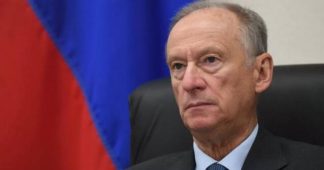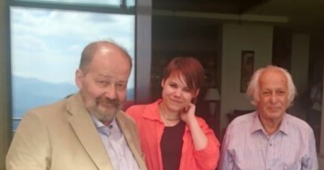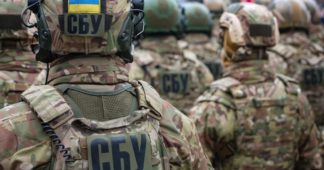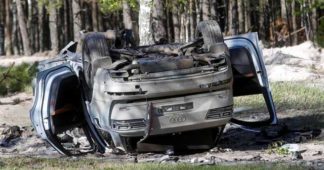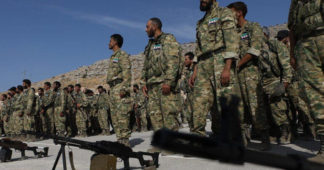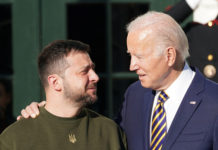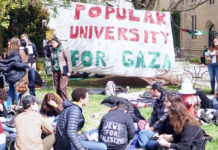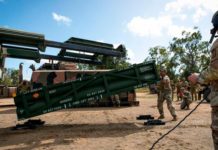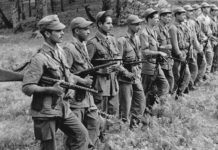By Jeremy Kuzmarov
In August 2022, Ukrainian security service (SBU) operatives hid explosives in a crate intended for a cat in a car driven by a woman and her twelve year old daughter. After the car passed through the Russian border, the SBU planted the bomb in the SUV of Russian journalist Darya Dugina, the daughter of well known philosopher Alexander Dugin, who was tragically killed.[1]
According to a new exposé in The Washington Post, which is based on interviews with more than two dozen Ukrainian, and U.S. intelligence officials, the Dugina bombing operation was part of a “raging shadow war” in which Ukraine’s spy services have twice bombed the bridge connecting Russia to occupied Crimea, piloted drones into the roof of the Kremlin, and blown holes in the hulls of Russian naval vessels in the Black Sea.[2]


The key agency helping to run this shadow war—you guessed it—is the Central Intelligence Agency (CIA), which according to The Post, formed, trained and equipped the SBU commando units that were involved in its key operations.
Since 2015, the CIA has spent tens of millions of dollars to transform Ukraine’s Soviet-formed intelligence services into potent allies against Moscow, officials said.
The agency has provided Ukraine with advanced surveillance systems, trained recruits at sites in Ukraine and in the U.S., built new headquarters for departments in Ukraine’s military intelligence agency, maintained a significant presence in Kyiv, and shared intelligence on a scale that would have been unimaginable before.
These revelations are not particularly surprising in light of what had already been disclosed. Vasily Prozorov, a former SBU officer who defected to Russia, publicly said that the SBU was advised by the CIA since 2014, and that CIA employees have come to the SBU’s central office to plot secret operations.

Plausible Deniability and the Birth of a New Mossad
As a key part of the shadow war, the SBU and its military counterpart, the GUR, have carried out dozens of assassinations of Russian officials in occupied territories, alleged Ukrainian collaborators, military officers behind the front lines and prominent war supporters deep inside Russia. Those killed include a blogger at a cafe in St. Petersburg.

A former CIA official was quoted in the The Post stating that “We are seeing the birth of a set of intelligence services that are like Mossad [the Israeli intelligence services known for carrying out assassassination] in the 1970s.”
Another U.S. intelligence official emphasized U.S. operational restrictions, stating that their focus was “more on secure communications and tradecraft,” and pursuing new streams of intelligence inside Russia “rather than ‘here’s how you blow up a mayor.’ I never got the sense that we were that involved in designing their ops.”
These latter comments can be seen as a form of plausible deniability in which the U.S. and CIA distances itself from atrocities that it commits by blaming them on its proxy forces.
The Post is generally known as a platform for “controlled leaks.”
Oleg Tsaryov, a member of Ukraine’s parliament from 2002-2014, said that the U.S. attempt to distance itself from the Dugina car bombing and other terrorist acts was disingenuous. He specified that the CIA and British MI6 ran the coup d’état in Kyiv in 2014, and said that he could name the officials in Kyiv who were in the pay of U.S. intelligence.[3]

Parallels with CIA Phoenix Program in Vietnam—with a New Twist
CovertAction Magazine has previously reported on a historical parallel with the CIA’s Vietnam Phoenix Program, where the CIA also claimed plausible deniability, blaming terrorist acts committed in an attempt to “neutralize” civilian officials supportive of the National Liberation Front (NLF) on proxy forces—Vietnamese Provincial Reconnaissance Units (PRUs), which were known for their brutality.
The CIA provided the PRU’s working under Phoenix—like their modern-day Ukrainian counterparts—with modern police technologies, trained them in intelligence gathering and interrogation techniques, and set up computerized databases of subversives who were targeted for liquidation.[4]

Though the CIA denies it is involved directly in kill-capture missions, it is doing the same things it did under Phoenix in helping Ukrainian intelligence operatives to collate and organize intelligence and to create blacklists and may be giving direct orders.
Civilian officials considered to be Russian collaborators or propagandists are on the blacklists. In a new twist, the CIA and SBU have made the death lists publicly accessible on the Myrotvorets website, which advertises itself as being run out of Langley.


“Our Little Baby”
The CIA’s close relationship with the SBU intensified right after the February 2014 Maidan coup, which resulted in the overthrow of pro-Russian leader Viktor Yanukovych and empowered a pro-Western regime led by Petro Poroshenko and then Volodymyr Zelensky.
Afterwards, the CIA worked with the SBU to create a new intelligence agency that would focus on “active measures” operations against Russia, whose government the U.S. wanted to remove.
Training sites were located outside Kyiv where handpicked recruits were instructed by CIA personnel. The plan was to form units “capable of operating behind front lines and working as covert groups,” said a Ukrainian official involved in the effort.
The agency provided secure communications gear, eavesdropping equipment that allowed Ukraine to intercept Russian phone calls and emails, and furnished disguises and separatist uniforms enabling operatives to more easily slip into occupied towns.
The early missions focused on recruiting informants among Russia’s proxy forces as well as cyber and electronic eavesdropping measures. The SBU also began mounting sabotage operations and missions to capture separatist leaders and Ukrainian collaborators, some of whom were taken to secret detention sites.

Over one three-year stretch, at least half a dozen Russian operatives, high-ranking separatist commanders or collaborators were killed in violence that was often attributed to internal score-settling but in reality was the work of the SBU, Ukraine officials said.
In 2016, Yevgeny Zhilin, the leader of a pro-Russian group in eastern Ukraine—whose people had been besieged by Ukrainians bombardment and atrocities since the Maidan coup and looked to Russia for protection—was gunned down in a Moscow restaurant.

The CIA devoted millions of dollars to building up the GUR, a smaller and more nimble organization which had fewer ex-KGB operatives than the SBU. A former U.S. intelligence official said that “GUR was our little baby. We gave them all new equipment and training.”
At sites in Ukraine and, later, the U.S., GUR operatives were trained in skills ranging from clandestine maneuvers behind enemy lines to the use of weapons platforms and explosives.
The CIA paid for new headquarters for the GUR’s spetsnaz paramilitary division and helped the GUR acquire state-of-the-art surveillance and electronic eavesdropping systems, as well as mobile equipment that could be placed along Russian-controlled lines in eastern Ukraine, and software tools used to exploit the cellphones of Kremlin officials visiting occupied territory from Moscow.
Ukrainian officers operated the systems but everything gleaned was shared with the Americans. Troves of data were relayed through the new CIA-built facility back to Washington, where they were scrutinized by CIA and NSA analysts.
In a measure of U.S.-Ukraine trust, officials said, the CIA was permitted to have direct contact with agents recruited and run by Ukrainian intelligence.

Framing the Narrative
GUR and SBU agent nets have assisted Ukraine in planning terrorist and drone attacks inside Russia proper, including attacks on the Kerch bridge and a May 2023 operation that set fire to a section of the roof in the Kremlin.

GUR’s venture into assassination included the murder of a Russian naval commander, Stanislav Rzhitsky whose location was exposed because of a fitness app that he used on his phone (Rzhitsky was shot dead on his morning run).

A Ukrainian security official told the The Post that this and other high-profile murders were “about narrative,” showing enemies of Ukraine that “punishment is imminent even for those who think they are untouchable.”
This explanation fits the classic definition of terrorism: an act of violence targeting civilians with the goal of furthering a political agenda or intimidating a population.
The CIA practiced terrorism routinely in the Cold War, displaying the corpses of dead guerrillas on lampposts in town squares for intimidation purposes under the Phoenix Program, for example.[5]

The same modus operandi is being adopted today in Ukraine in another dirty war being co-directed by the CIA. This war is even more dangerous than before because it is being carried out on Russian soil in a country that possesses nuclear weapons.
- Dugin was branded as a fascist in U.S. media but a review of his writings shows him to have repudiated fascism, and to have developed his own hybrid philosophy. He was primarily a Russian nationalist supportive of a Eurasian Union. ↑
- Greg Miller and Isabelle Khurshudyan, “Ukrainian Spies With Deep Ties to CIA Wage Shadow War Against Russia,” The Washington Post, October 23, 2023. ↑
- After issuing a public statement, Tsaryov, who served as an adviser to Ukrainian Prime Minister Myloa Azarov in 2014 speaker of the parliament of “Novorossiya,” a short-lived confederation of the Donetsk and Luhansk separatist governments that had been endorsed by the Kremlin and openly sought an annexation into Russia, was the target of an attempted assassination and was shot twice while at a spa hotel in Yalta in Crimea where he lives in the latest Phoenix style attack by Ukraine’s CIA-trained secret services. ↑
- See Douglas Valentine, The Phoenix Program (New York: William & Morrow, 1991). For the antecedents of Phoenix and how it evolved out of clandestine police training programs in the Cold War, see Jeremy Kuzmarov, Modernizing Repression: Police Training and Nation Building in the American Century (Amherst, MA: University of Massachusetts Press, 2012). ↑
- This was known as the “vampire trick” and it was earlier promoted in the Philippines against the Huk left-wing rebels. See Jonathan Nashel, Edward Lansdale’s Cold War (Amherst, MA: University of Massachusetts Press, 2005). ↑
We remind our readers that publication of articles on our site does not mean that we agree with what is written. Our policy is to publish anything which we consider of interest, so as to assist our readers in forming their opinions. Sometimes we even publish articles with which we totally disagree, since we believe it is important for our readers to be informed on as wide a spectrum of views as possible.
